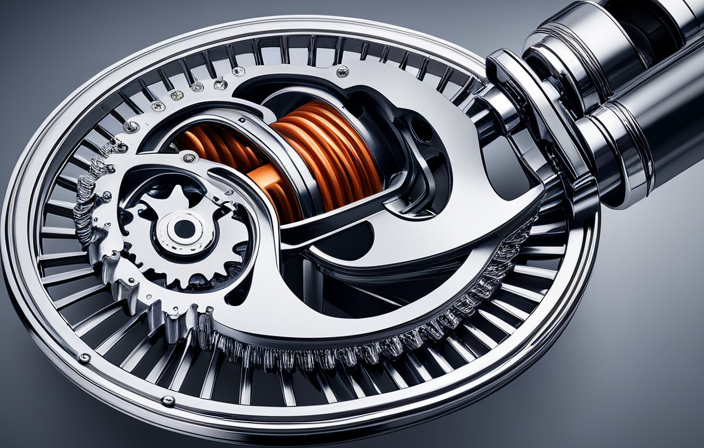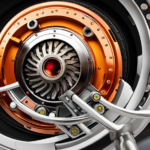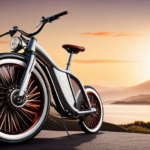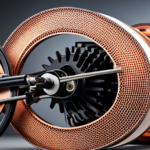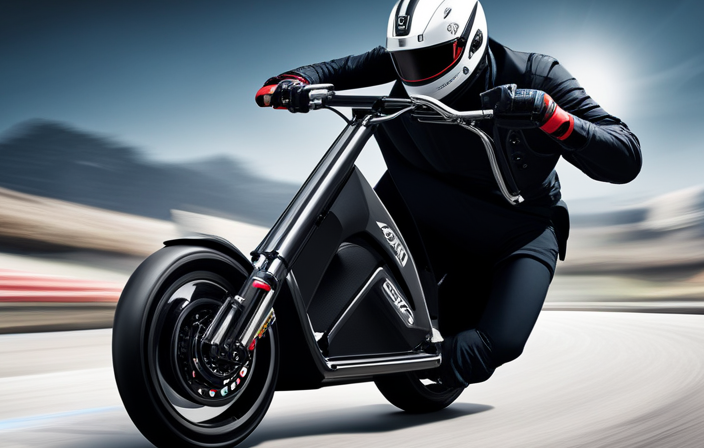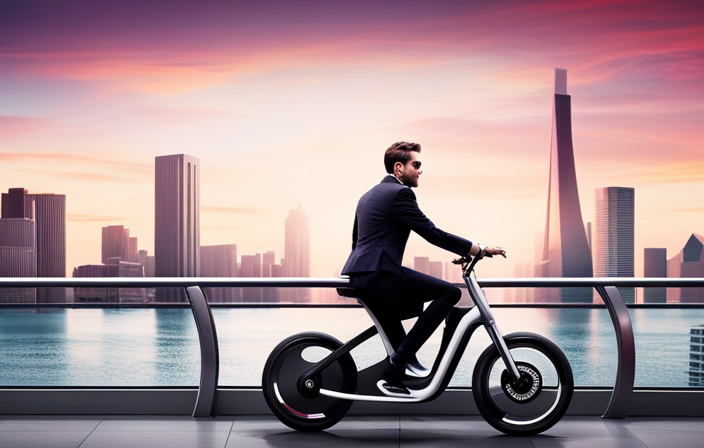Riding an electric bike is like harnessing the power of a lightning bolt. With each pedal stroke, the electric motor comes alive, propelling you forward with a surge of energy.
But have you ever wondered how this technological marvel actually works? In this article, I will delve into the intricate inner workings of electric bike motors, explaining everything from power generation to speed control.
So, fasten your helmet and prepare to embark on a technical journey through the fascinating world of electric bike motors.
Key Takeaways
- Electric bike motors generate power through a combination of motor efficiency and power generation techniques.
- Riders have options for speed and power control, and sensors play a role in optimizing motor performance.
- The components of an electric bike motor system include the motor, gear system, controller, and wiring, each with its own function and importance.
- Electric motors are highly efficient and the gear system has a significant impact on motor performance.
The Basics of Electric Bike Motors
If you want to understand how electric bike motors work, you need to start with the basics. Understanding motor efficiency and troubleshooting common motor issues is crucial in maintaining and optimizing your electric bike’s performance.
Motor efficiency refers to how effectively the motor converts electrical energy into mechanical energy, and it is influenced by factors like the motor’s design, size, and materials used.
Troubleshooting common motor issues involves identifying and resolving problems such as overheating, noise, or loss of power.
By understanding these concepts, you can ensure that your electric bike motor is operating at its best.
Now, let’s move on to the next section and delve into understanding the different types of electric bike motors.
Understanding the Different Types of Electric Bike Motors
To understand the different types of electric bike motors, you should familiarize yourself with their various features and functionalities. When it comes to electric bike motor efficiency, there are notable differences between brands.
One popular brand is Bosch, known for its high-quality motors that offer excellent performance and reliability. Another brand to consider is Shimano, which offers a range of motors with different power outputs and torque levels to suit various riding styles.
In terms of comparison, Bosch motors are known for their efficiency and smooth power delivery, making them ideal for long-distance riding. On the other hand, Shimano motors are known for their compact design and lightweight construction, making them suitable for off-road and mountain biking.
Understanding these differences can help you make an informed decision when choosing an electric bike motor.
Now, let’s delve into how electric bike motors generate power.
How Electric Bike Motors Generate Power
Electric bike motors generate power through the conversion of electrical energy into mechanical energy. This process is essential for the motor to propel the bike forward. The efficiency of an electric bike motor is crucial because it determines how much energy is converted into useful mechanical work. Higher efficiency means less energy is wasted, resulting in a longer battery life and a more sustainable mode of transportation.
The impact of electric bike motors on the environment is significant. By using electric power instead of gasoline, these motors produce zero direct emissions, reducing air pollution and greenhouse gas emissions. Additionally, electric bike motors have a lower carbon footprint compared to traditional combustion engines.
Controlling the speed and power of electric bike motors is the next step in understanding how these motors work.
Controlling the Speed and Power of Electric Bike Motors
When controlling the speed and power of your electric bike motor, you have the ability to adjust its performance according to your preferences and needs.
Speed control is an important aspect of electric bike motors, as it allows you to determine how fast you want to go. Most electric bike motors come with different speed settings that you can choose from, ranging from low to high.
Power management is another crucial feature that enables you to regulate the amount of power delivered by the motor. This is especially useful when you need to conserve battery life or when tackling challenging terrains.
By effectively managing the speed and power of your electric bike motor, you can optimize your riding experience and ensure the motor performs efficiently.
Now, let’s delve into the role of sensors in electric bike motors.
The Role of Sensors in Electric Bike Motors
To optimize your riding experience and ensure efficient performance, sensors play a crucial role in electric bike motors. Sensors in electric bike motors are responsible for monitoring and controlling various aspects of the motor’s operation.
The main function of sensors is to gather data and provide feedback to the motor controller, allowing it to make real-time adjustments to the motor’s speed, power, and torque output. There are different types of sensors used in electric bike motors, such as speed sensors, torque sensors, and cadence sensors.
Each type of sensor measures specific parameters, enabling the motor controller to accurately respond to the rider’s input and optimize the motor’s performance accordingly. The presence of sensors in electric bike motors significantly impacts their overall performance, ensuring a smooth and efficient riding experience.
Moving on to the mechanics of electric bike motor components…
The Mechanics of Electric Bike Motor Components
The mechanics of electric bike motor components are crucial in understanding how the motor functions.
The electric motor itself is responsible for converting electrical energy into mechanical energy, providing the power needed to propel the bike forward.
The gear system plays a vital role in controlling the torque and speed of the motor, allowing for efficient power transfer.
Additionally, the controller acts as the brain of the motor, regulating the flow of electricity and managing various functions.
Proper wiring and connectors ensure a reliable and efficient electrical connection throughout the motor system, enabling seamless communication between components.
Electric Motor
An electric motor uses electromagnetic force to convert electrical energy into mechanical energy. It is a crucial component of an electric bike, responsible for propelling the bike forward.
Here are three key aspects of electric motors in the context of electric bikes:
-
Electric motor efficiency: Electric motors are highly efficient in converting electrical energy into mechanical energy. They can achieve efficiency levels above 90%, which means that only a small amount of energy is lost as waste heat.
-
Electric motor torque: Torque refers to the rotational force produced by the motor. Electric motors can provide high torque at low speeds, making them ideal for starting and climbing hills. This characteristic is especially beneficial for electric bikes that need extra power in these situations.
-
Electric motor control: Electric motors in e-bikes can be controlled through various means, such as throttle control or pedal-assist systems. These controls allow riders to adjust the motor’s power output according to their preferences and riding conditions.
Now, let’s delve into the next section about the ‘gear system’ and explore how it complements the electric motor’s performance.
Gear System
Take a moment to understand how the gear system enhances your riding experience.
The gear system in an electric bike motor is responsible for transferring power from the motor to the wheels. It consists of a set of gears of different sizes, which are connected by a chain. By changing the gear ratio, the rider can optimize the efficiency of the motor.
A higher gear ratio allows the motor to spin faster, providing more power but requiring more effort from the rider. On the other hand, a lower gear ratio allows for easier pedaling but sacrifices speed and power. By adjusting the gear ratio, riders can find the perfect balance between power and efficiency for their specific needs.
This optimization of efficiency is crucial in maximizing the battery life and overall performance of the electric bike.
Moving on to the next section about the ‘controller’, let’s explore how it regulates the power output of the motor.
Controller
Now that we understand how the gear system of an electric bike works, let’s dive into the next crucial component: the electric bike controller. The controller serves as the brain of the electric bike, responsible for managing the power flow from the battery to the motor. It receives signals from the throttle or pedal assist sensor and adjusts the power output accordingly. The electric bike controller is equipped with power management features, allowing riders to control the speed and torque of the motor. It ensures a smooth and efficient ride by regulating the current flow and protecting the motor from overheating or overloading.
To further understand the functionality of the electric bike controller, let’s take a look at the following table, showcasing its key features:
| Features | Benefits |
|---|---|
| Power management | Efficient use of battery power |
| Speed control | Adjust speed according to riding conditions |
| Torque control | Enhance uphill performance |
| Overload protection | Prevent motor damage and ensure longevity |
With a solid understanding of the electric bike controller, we can now move on to the next section about wiring and connectors.
Wiring and Connectors
To understand wiring and connectors, you need to learn about how they connect different components of your electric bike.
The wiring in an electric bike is responsible for carrying the electrical current from the battery to various components such as the motor, controller, and throttle. It is crucial to ensure wiring compatibility between these components to avoid any electrical issues.
When dealing with wiring and connectors, troubleshooting tips can come in handy. For instance, if there is a problem with your electric bike, you can start by checking the wiring connections to make sure they are secure and properly connected. Additionally, it is important to inspect the wiring for any signs of damage or wear. By following these troubleshooting tips, you can identify and resolve any wiring-related issues.
Moving on, let’s now explore the advantages of electric bike motors.
The Advantages of Electric Bike Motors
When it comes to electric bike motors, there are several advantages that make them a popular choice among riders like myself.
Firstly, electric bike motors provide increased range and speed, allowing me to cover more distance and reach higher speeds than I would with a regular bike.
Secondly, these motors make hill climbing much easier, as they provide an extra boost of power that helps me conquer steep inclines with less effort.
Lastly, electric bike motors reduce the overall effort required from riders, making it a more enjoyable and less strenuous experience.
Increased Range and Speed
Get ready to experience a longer range and faster speeds with an electric bike motor. Thanks to increased power efficiency and battery technology advancements, electric bike motors are now capable of providing riders with a significant boost in both range and speed.
Here’s what you can expect:
-
Extended Range: With improved power efficiency, electric bike motors can now go the extra mile, allowing you to travel longer distances without worrying about running out of battery power.
-
Increased Speed: Electric bike motors have also become faster, enabling you to reach higher speeds while effortlessly cruising through city streets or tackling challenging terrains.
These advancements in electric bike motor technology have revolutionized the way we ride, making electric bikes a viable alternative to traditional bicycles. With the increased range and faster speeds, you’ll have the confidence to conquer any journey, including easier hill climbing.
Easier Hill Climbing
Conquering hills is now easier than ever with the advancements in electric bike motor technology. With improved battery technology and efficient motor design, electric bikes are able to provide the necessary power and torque to tackle even the steepest of inclines. When faced with a hill, the electric motor kicks in, providing an extra boost of power to assist the rider. This makes hill climbing much easier and less strenuous compared to traditional bicycles. To understand how the electric bike motor works during hill climbing, let’s take a look at the following table:
| Hill Gradient (%) | Motor Power Output (%) |
|---|---|
| 0-5 | 100 |
| 6-10 | 80 |
| 11-15 | 60 |
As the hill gradient increases, the motor power output decreases, allowing the rider to maintain a steady pace while exerting less effort. This reduced effort for riders is a significant advantage of electric bike motors and will be further explored in the next section.
Reduced Effort for Riders
You’ll experience less exertion as you ride, thanks to the reduced effort made possible by advancements in electric bike motor technology. These advancements have led to increased efficiency in electric bike motors, allowing riders to go further with less physical effort.
Here are four ways in which these advancements have improved the riding experience:
-
Enhanced power delivery: Modern electric bike motors provide a smooth and consistent power delivery, ensuring a more effortless ride.
-
Improved torque sensors: Advanced torque sensors in electric bike motors accurately measure the rider’s pedaling force, providing just the right amount of assistance when needed.
-
Optimal power-to-weight ratio: Electric bike motors now have a higher power-to-weight ratio, resulting in a lighter and more agile ride.
-
Extended battery lifespan: The increased efficiency of electric bike motors means that the battery lasts longer, allowing riders to go on longer trips without worrying about running out of power.
With these improvements, riding an electric bike requires less effort while providing increased efficiency and longer battery lifespan. Transitioning to the subsequent section about maintenance and care for electric bike motors, it is essential to understand how to keep these advancements in top condition.
Maintenance and Care for Electric Bike Motors
Take good care of your electric bike motor by regularly cleaning it and checking for any signs of wear or damage. Proper maintenance is essential for keeping your motor running smoothly and extending its lifespan. Here are some maintenance tips to ensure optimal performance.
- Firstly, clean the motor regularly using a mild detergent and water, avoiding direct contact with electrical components.
- Inspect the motor for loose wires, loose connections, or any visible damage.
- Lubricate the moving parts of the motor, such as the bearings, with a suitable lubricant to reduce friction and ensure smooth operation.
- Troubleshooting common issues like unusual noises or decreased power can often be resolved by checking the battery connections, throttle, or controller settings.
By following these maintenance practices, you can enjoy a reliable and efficient electric bike experience.
Moving on to safety considerations for electric bike motors, it’s crucial to prioritize rider protection and adhere to local traffic regulations.
Safety Considerations for Electric Bike Motors
It’s important to prioritize rider protection and adhere to local traffic regulations when considering the safety of electric bike motors. Safety regulations play a crucial role in ensuring the safe operation of electric bikes. It is essential to follow these regulations to prevent accidents and protect both riders and pedestrians.
Additionally, wearing proper protective gear is vital to minimize the risk of injury in case of an accident. Helmets, knee pads, and reflective clothing can significantly reduce the severity of injuries.
Adhering to traffic rules, such as obeying speed limits and using turn signals, is also crucial for the safety of electric bike riders. These measures promote safer riding experiences and help create a harmonious environment between electric bike riders and other road users.
Looking ahead, the future of electric bike motors holds exciting advancements and innovations that will further enhance both performance and safety.
The Future of Electric Bike Motors
Innovation and advancements in the field show promising potential for the future of e-bike motors. As technology continues to improve, we can expect exciting developments that will enhance the performance and efficiency of electric bike motors.
Here are three key areas that will shape the future of electric bike motors:
-
Battery Technology: Improvements in battery technology will lead to increased energy density, allowing for longer rides and faster charging times. This will make electric bikes more practical and convenient for everyday use.
-
Motor Efficiency: Future advancements in motor design and materials will result in more efficient electric bike motors. This means less energy waste and increased range for riders.
-
Environmental Impact: The future of electric bike motors will prioritize sustainability and environmental impact. Manufacturers will focus on reducing the carbon footprint of e-bikes and ensuring that they are eco-friendly transportation options.
These advancements in e-bike motor technology will not only improve performance but also contribute to a greener and more sustainable future.
Frequently Asked Questions
How do electric bike motors compare to traditional bike motors?
Electric bike motors have several advantages over traditional scooter motors. They offer a more efficient and eco-friendly option, with better torque and acceleration. Additionally, electric bike motors require less maintenance and provide a smoother and quieter ride.
Are electric bike motors suitable for off-road biking?
Yes, electric bike motors are suitable for off-road biking. With an average power output of 500 watts, they provide superior torque and acceleration compared to traditional bike motors. The advantages of electric bike motors include increased speed, range, and the ability to conquer challenging terrains.
Can electric bike motors be used in conjunction with manual pedaling?
Yes, electric bike motors can be used in conjunction with manual pedaling. This combination increases electric bike motor efficiency and provides benefits such as extended range, improved fitness, and the ability to tackle steep hills with less effort.
What is the average lifespan of an electric bike motor?
The average lifespan of an electric bike motor depends on various factors such as usage, maintenance, and quality. Regular electric bike motor maintenance and early detection of signs of a failing motor can help prolong its lifespan.
Are there any legal restrictions or regulations for using electric bike motors on public roads?
There are legal restrictions and regulations for using electric bike motors on public roads. Ensuring electric bike motor safety is crucial. However, the benefits of using electric bike motors on public roads include reduced emissions, improved fuel efficiency, and decreased traffic congestion.
Conclusion
In conclusion, electric bike motors are an incredible innovation that has revolutionized the way we travel and commute. With their ability to generate power through various mechanisms, control speed and power, and utilize sensors for seamless operation, electric bike motors offer a multitude of advantages.
One fascinating statistic to note is that electric bikes can travel at speeds of up to 28 miles per hour, making them a fast and efficient mode of transportation.
As we look to the future, the development of electric bike motors holds great potential for further advancements in the field of sustainable transportation.
